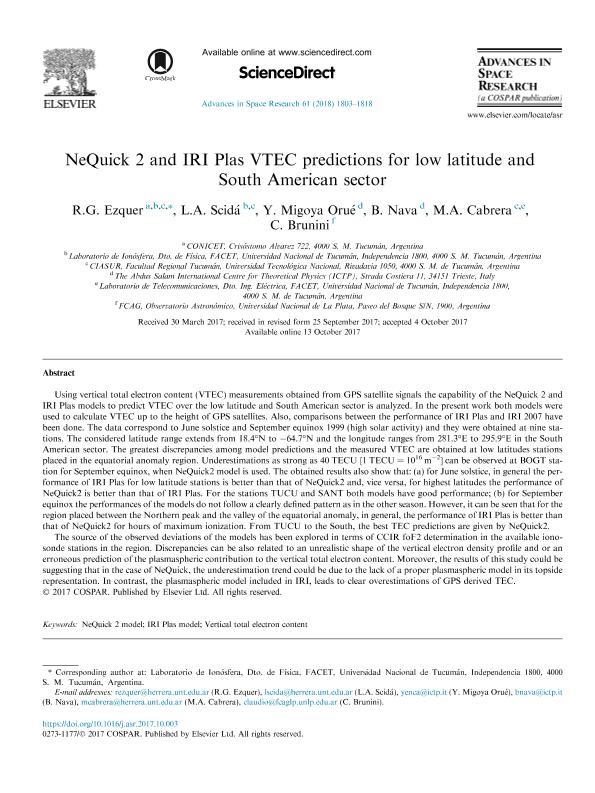Mostrar el registro sencillo del ítem
dc.contributor.author
Ezquer, Rodolfo Gerardo

dc.contributor.author
Scida, Luis Alberto

dc.contributor.author
Migoya Orue, Yenca Olivia

dc.contributor.author
Nava, B.
dc.contributor.author
Cabrera, Miguel Angel

dc.contributor.author
Brunini, Claudio Antonio

dc.date.available
2019-08-12T12:27:58Z
dc.date.issued
2018-04
dc.identifier.citation
Ezquer, Rodolfo Gerardo; Scida, Luis Alberto; Migoya Orue, Yenca Olivia; Nava, B.; Cabrera, Miguel Angel; et al.; NeQuick 2 and IRI Plas VTEC predictions for low latitude and South American sector; Elsevier; Advances in Space Research; 61; 7; 4-2018; 1803-1818
dc.identifier.issn
0273-1177
dc.identifier.uri
http://hdl.handle.net/11336/81388
dc.description.abstract
Using vertical total electron content (VTEC) measurements obtained from GPS satellite signals the capability of the NeQuick 2 and IRI Plas models to predict VTEC over the low latitude and South American sector is analyzed. In the present work both models were used to calculate VTEC up to the height of GPS satellites. Also, comparisons between the performance of IRI Plas and IRI 2007 have been done. The data correspond to June solstice and September equinox 1999 (high solar activity) and they were obtained at nine stations. The considered latitude range extends from 18.4°N to −64.7°N and the longitude ranges from 281.3°E to 295.9°E in the South American sector. The greatest discrepancies among model predictions and the measured VTEC are obtained at low latitudes stations placed in the equatorial anomaly region. Underestimations as strong as 40 TECU [1 TECU = 1016 m−2] can be observed at BOGT station for September equinox, when NeQuick2 model is used. The obtained results also show that: (a) for June solstice, in general the performance of IRI Plas for low latitude stations is better than that of NeQuick2 and, vice versa, for highest latitudes the performance of NeQuick2 is better than that of IRI Plas. For the stations TUCU and SANT both models have good performance; (b) for September equinox the performances of the models do not follow a clearly defined pattern as in the other season. However, it can be seen that for the region placed between the Northern peak and the valley of the equatorial anomaly, in general, the performance of IRI Plas is better than that of NeQuick2 for hours of maximum ionization. From TUCU to the South, the best TEC predictions are given by NeQuick2. The source of the observed deviations of the models has been explored in terms of CCIR foF2 determination in the available ionosonde stations in the region. Discrepancies can be also related to an unrealistic shape of the vertical electron density profile and or an erroneous prediction of the plasmaspheric contribution to the vertical total electron content. Moreover, the results of this study could be suggesting that in the case of NeQuick, the underestimation trend could be due to the lack of a proper plasmaspheric model in its topside representation. In contrast, the plasmaspheric model included in IRI, leads to clear overestimations of GPS derived TEC.
dc.format
application/pdf
dc.language.iso
eng
dc.publisher
Elsevier

dc.rights
info:eu-repo/semantics/openAccess
dc.rights.uri
https://creativecommons.org/licenses/by-nc-sa/2.5/ar/
dc.subject
Iri Plas Model
dc.subject
Nequick 2 Model
dc.subject
Vertical Total Electron Content
dc.subject.classification
Meteorología y Ciencias Atmosféricas

dc.subject.classification
Ciencias de la Tierra y relacionadas con el Medio Ambiente

dc.subject.classification
CIENCIAS NATURALES Y EXACTAS

dc.title
NeQuick 2 and IRI Plas VTEC predictions for low latitude and South American sector
dc.type
info:eu-repo/semantics/article
dc.type
info:ar-repo/semantics/artículo
dc.type
info:eu-repo/semantics/publishedVersion
dc.date.updated
2019-08-07T14:06:42Z
dc.journal.volume
61
dc.journal.number
7
dc.journal.pagination
1803-1818
dc.journal.pais
Países Bajos

dc.journal.ciudad
Amsterdam
dc.description.fil
Fil: Ezquer, Rodolfo Gerardo. Universidad Tecnológica Nacional; Argentina. Consejo Nacional de Investigaciones Científicas y Técnicas. Centro Científico Tecnológico Conicet - Tucumán; Argentina
dc.description.fil
Fil: Scida, Luis Alberto. Universidad Nacional de Tucumán; Argentina
dc.description.fil
Fil: Migoya Orue, Yenca Olivia. Consejo Nacional de Investigaciones Científicas y Técnicas; Argentina
dc.description.fil
Fil: Nava, B.. Universidad Nacional de Tucumán; Argentina
dc.description.fil
Fil: Cabrera, Miguel Angel. Universidad Tecnológica Nacional; Argentina
dc.description.fil
Fil: Brunini, Claudio Antonio. The Abdus Salam. International Centre for Theoretical Physics; Italia. Universidad Nacional de La Plata; Argentina. Consejo Nacional de Investigaciones Científicas y Técnicas. Centro Científico Tecnológico Conicet - La Plata; Argentina
dc.journal.title
Advances in Space Research

dc.relation.alternativeid
info:eu-repo/semantics/altIdentifier/url/https://www.sciencedirect.com/science/article/pii/S027311771730724X?via%3Dihub
dc.relation.alternativeid
info:eu-repo/semantics/altIdentifier/doi/https://doi.org/10.1016/j.asr.2017.10.003
Archivos asociados
